Progress in technology, coupled with medical and scientific advances, is expected to significantly change the healthcare environment. Technology companies, healthcare companies, medical device companies, and others are capitalizing on emerging technologies to provide novel healthcare solutions using mHealth, sensors, data analytics, bioinformatics, and advanced software. The result will be a medical environment that takes advantage of “smart" technologies for improved healthcare decision-making and better patient outcomes.
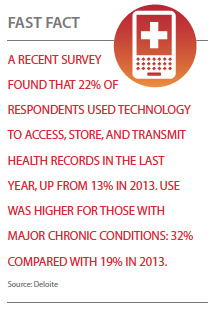 Experts say smart technologies already support individual health monitoring by physicians, but also have the ability to provide data to insurance companies and government agencies on a massive scale.
Experts say smart technologies already support individual health monitoring by physicians, but also have the ability to provide data to insurance companies and government agencies on a massive scale.
The first wave of mHealth technologies has focused mainly on capturing data and, to some extent, presenting it back to the user, says Matthew Noble, senior director, product management, at Medidata Solutions.
“But users have had to go out of their way and do their own research to discover the meaning behind these data," he says. “Smarter mHealth technologies coming out now are focused on providing the consumer and patient with actionable guidance based on the data."
In 2016 there will continue to be an evolution around augmented intelligence, which is being applied on a trial basis in different therapeutic areas, says Glenn Snyder, principal, med tech segment leader, at Deloitte Consulting.
“We’ll see augmented intelligence come into play in decision support," he says. “As companies develop data, data sensors, and data sources, the key will be coming up with an intelligent way to interpret that data."
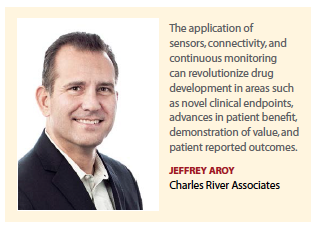 Mr. Noble says smarter, more actionable insights will become more prominent as new technologies integrate the use of multiple sensors. For example, a sensor that takes multiple measurements, such as respiration and heart rate or heart rate and sweat analysis, will provide the patient with a more complete picture of his or her health.
Mr. Noble says smarter, more actionable insights will become more prominent as new technologies integrate the use of multiple sensors. For example, a sensor that takes multiple measurements, such as respiration and heart rate or heart rate and sweat analysis, will provide the patient with a more complete picture of his or her health.
“Medical technologies need to be smarter, because long-term patient adherence is challenging," he says. “Studies have shown a severe drop-off in wearable use within months of purchase."
The continued growth in smart medical technology will deliver innumerable ways to capture and analyze data, says Jennifer Sigaud, managing director at Atlantis Healthcare US.
“But for technology to be effective, its design and application need to be based on insights around the users, the people whose data it seeks to measure," she says. “This is especially true in programs created to improve treatment adherence. To determine the right tool, pharma needs to look beyond demographics at patient beliefs and behaviors. There needs to be a variety of vehicles to accommodate preferences and learning styles, including video, practical and organizational challenges, or cognitive/behavioral activities. This patient-driven approach to smart technology will help create clear-cut goals at the beginning of interventions, allowing pharma to use technology to its fullest potential."
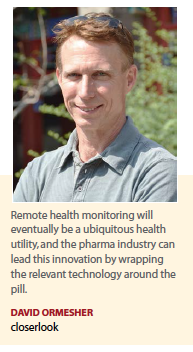 David Ormesher, CEO of closerlook, says smart medtech will have an impact on healthcare for two reasons.
David Ormesher, CEO of closerlook, says smart medtech will have an impact on healthcare for two reasons.
“To achieve health at a lower cost we need to monitor and intervene before an expensive acute hospitalization and do it with a scalable architecture and technology enables both," he says. “Wearable sensors enable passive and continuous data collection, which is much more accurate and comprehensive than sporadic or self-reported data. Wireless and cloud-based analytics will sift the signal from the noise and flag meaningful variances on a personalized basis, screening out false positives, and notify the most appropriate HCP. With the cost of sensors and power of analytics following Moore’s Law, remote health monitoring will eventually be a ubiquitous health utility, and pharma can lead this innovation by wrapping the relevant technology around the pill."
David Moore, group director of Ashfield Healthcare Communications, says two areas stand out in terms of where smart technology is heading.
“Smart diagnostic devices is one area that will have a tremendous impact on how healthcare is delivered in the future," he says. “There are a lot of these devices in pilot now. Some are set up to be simple, inexpensive devices to take patient vitals, for instance. But where they vary significantly in addition to production costs, is their ability to feed data into a central data repository giving physicians, and sometimes patients, the ability to use that data on a regular basis."
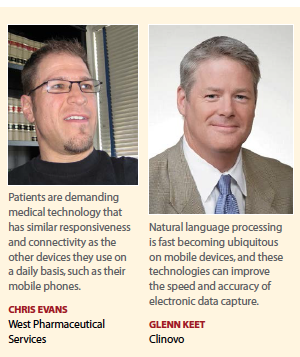 Mr. Moore says some of these diagnostic tools are being designed to measure specific disease markers, giving an individual test results in 20 minutes rather than two to three weeks, and doing so for less than $100 vs. the $2,000 to $3,000 today’s testing might cost.
Mr. Moore says some of these diagnostic tools are being designed to measure specific disease markers, giving an individual test results in 20 minutes rather than two to three weeks, and doing so for less than $100 vs. the $2,000 to $3,000 today’s testing might cost.
“Think of the impact such devices would have on reducing emotional distress and making testing far more affordable for everyone," he says.
Behind the Smart Tech Trend
There is a definite convergence of IT and medicine happening today, says William Hunter, M.D., president and CEO of Cardiome.
“Med tech is going to take a massive leap forward, offering the opportunity to learn about what actually goes on inside the human body," he says. “I can see a talking hip joint that will be able to provide insight about the force patterns on human joints or in a replaced joint. You’ll actually be able to see how it moves in free space. We will have real-time data and big data analytics to look for patterns. This will be a huge step forward in medicine.
“Imagine if a coronary stent had similar capabilities," Dr. Hunter continues. “A patient may have some chest pain and he or she could check that there is still flow through the coronary stent via an iPhone.
The patient can see that there isn’t a problem with the stent; it’s the pizza he or she had at lunch. So from the patient perspective, data that really matters would be able to provide objective feedback."
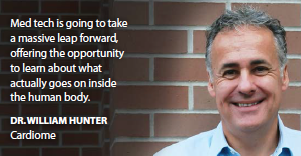 There are several factors contributing to this drive toward smart medical technologies, including curbing costs in healthcare while potentially creating greater patient access to quality healthcare and improved outcomes.
There are several factors contributing to this drive toward smart medical technologies, including curbing costs in healthcare while potentially creating greater patient access to quality healthcare and improved outcomes.
Mr. Snyder says consumers are a big driver of the trend of smart technology.
“Consumers expect to be able to access and understand their health, just like they do with their purchasing experience of buying something through an app or online retailer," he says. “They are creating a demand for mobile and digital health solutions, and companies are frankly responding to consumer demand. The innovators in the market are already building those solutions. Well-established companies, such as Medtronic, are getting into monitoring services as a way to offer a value proposition for the healthcare system. They understand that value-based care — moving from volume to value — is the new paradigm in the healthcare industry."
In fact, Americans are increasing their use of technology to improve their health, navigate the health system, and flex their shopping muscles in acting like consumers instead of passive patients, according to a survey released in October by The Deloitte Center for Health Solutions. The report found that 22% of respondents used technology to access, store, and transmit health records in the last year, up from 13% in 2013. Use was higher for those with major chronic conditions: 32% compared with 19% in 2013.
The Deloitte report also shows that 16% of respondents who needed care went online for cost information, up from 11% in 2013. Millennials in this group increased the most, 27% versus 17%. When it comes to judging quality, 25% of all respondents used a scorecard to compare the performance of doctors, hospitals and/or health plans, up from 19% in 2013.
Mr. Snyder says collaborations will be critical for the development of these newer smart technologies.
“Most companies aren’t going to be able to build all of the points of data creation — communication, aggregation, analysis, and scripted behavior — for both clinicians and patients," he says. “What’s going to be an interesting trend to watch is the number of high-tech med-tech collaborations across the existing segments of the healthcare value chain care, including provider and manufacturer."
Pharma’s Role in Smart Technology
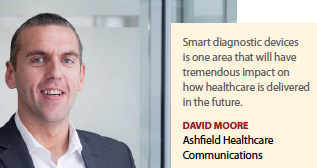 Pharma companies have a huge role to play in influencing smarter medical technologies. Experts say the downward pressure on the price of technologies, the general increase in digital acumen of most demographics of the population, and the quest for pharma to add value beyond the pill are all factors driving the trend toward smart medical technologies.
Pharma companies have a huge role to play in influencing smarter medical technologies. Experts say the downward pressure on the price of technologies, the general increase in digital acumen of most demographics of the population, and the quest for pharma to add value beyond the pill are all factors driving the trend toward smart medical technologies.
Consumer health applications on devices like mobile phones are grabbing a lot of headlines, but the data and devices that can impact pharmaceuticals may be much more aligned with traditional drug development. Experts say pharma has a huge stake in developing medical technologies, and some say what pharma lacks is the ability to function like a Silicon Valley start-up company.
Chris Evans, VP, research and innovation at West Pharmaceutical Services, says nonadherence is a big driver in the trend for smart technologies.
“To improve this very real challenge, it is critical for pharmaceutical and biopharmaceutical companies to anticipate and understand the changing needs of patients," he says. “Patients are demanding medical technology that has similar responsiveness and connectivity as the other devices they use on a daily basis — such as their mobile phones."
Mr. Evans says the industry is responding with innovative breakthroughs that may result in better patient outcomes.
“For example, electronically connected drug delivery devices that can track in real-time when patients take their medication have the ability to educate patients and motivate them toward increased adherence," he says. “While innovating, we also have a responsibility to make smart technologies easy to use so that the technology itself doesn’t become a barrier to medication compliance."
Jeffrey Aroy, a consultant at Charles River Associates, says as therapeutic areas mature, it is getting more difficult to differentiate products clinically and to justify premium pricing. Sensors and monitoring can provide a path to a premium product in therapeutic areas with multiple competitors.
“A manufacturer recently introduced a product into the crowded treatment field of pulmonary hypertension," he says. “Clinical trials using traditional endpoints of how far patients could walk in six minutes produced an approvable, but undifferentiated product. The company identified implantable sensor technology that was able to continuously monitor and report inter-arterial pressures in the lungs that the class of drugs treated. This allowed the company to mine a variety of novel endpoints that were seen as very relevant to treatment goals like end organ efficacy, treatment peak and trough effects, and pressure upon waking when drug load was lowest. By studying the drug in this way, they are on a path to create differentiation and clinical claims that none of their competitors will be able to match."
Increasingly, regulators and payers want to see data that proves a better patient experience; this should start early in the clinical development plan of a new therapy, Mr. Noble says.
“By focusing on the use of new technologies to better understand disease progression and efficacy of therapy during the clinical development phase of a drug’s life, R&D organizations can set up their commercial side with differentiating therapies," he says.
Mr. Noble says development teams can bring to market apps that not only prove efficacy, but also actually improve medication adherence, which is a multi-billion dollar opportunity.
“Apps with smart alerts that know when and how best to prod patients to take their drugs should be studied and developed alongside drug programs," he says. “It’s just as important to research these types of solutions to maximize results."
Mr. Aroy says the application of sensors, connectivity, and continuous monitoring can revolutionize drug development in areas such as novel clinical endpoints, advances in patient benefit, demonstration of value, and in patient reported outcomes.
“One example is leveraging and networking smart devices," he says. “These can be smartphone-based, they also can be intelligence built into administration devices like pill dispensers. One company decided to attack the problem of patient adherence for its injectable treatment in multiple sclerosis.
They developed a smart pen injector that monitors whether patients are making their injections on schedule, and they paired this with an application that gathers other patient related outcomes and collects the data centrally. This enables the brand to intervene with noncompliant patients via their physicians, specialty pharmacies, or the brand’s nurse call center."
Mr. Aroy says such an integrated device and network solution offers the potential to improve compliance, which may translate into improved patient outcomes.
“Companies are able to demonstrate better value for payers as patients actually take and benefit from the drug for which the payer has paid," he says. “One could imagine applying solutions like this prospectively in clinical development to maximize efficacy outcomes and to capture patient reported outcomes that could differentiate new products."
Sensor and other smart technologies are improving data capture for clinical trials, says Glenn Keet, CEO of Clinovo.
“Speeding up trials and reducing data errors will significantly reduce the total costs of trials, ultimately bringing better solutions to more patients," he says. “For example, speech recognition and natural language processing are fast becoming ubiquitous on mobile devices, and these technologies can improve the speed and accuracy of electronic data capture versus translation from handwritten or even typed data entry on a computer."
Importantly, Mr. Keet says, these advanced technologies will not only be used by clinical trial professionals, but also by patients in ePRO applications, which will increase their utilization as well as the compliance, further improving trial data.
“Pharma understands disease and treatment options and is in a position to bring that expertise to the table," Mr. Moore says. “There are many chronic diseases such as asthma and diabetes that now offer far superior diagnostic or treatment devices as a result of such partnerships. These have led to greater patient adherence to the respective therapies and ultimately, adherence is what is needed to improve patient outcomes."
Technology’s ability to capture data with devices is a key driver to pharma taking part in such development, Mr. Moore says.
“Take a patient suffering with asthma," he says. “An inhaler could have the ability to capture data such as adherence, lung capacity, and other factors that the physician and patient can see. There is the potential that a patient could be rewarded for his or her adherence behavior with something like an online game for a juvenile or some other motivational prize for an adult. But most importantly, all that data can be fed back to the physician, who can in turn see any symptoms or behaviors that might need correction, and act accordingly. Up until now, physicians have been relying on patient diaries for some of these chronic conditions." (PV)


















